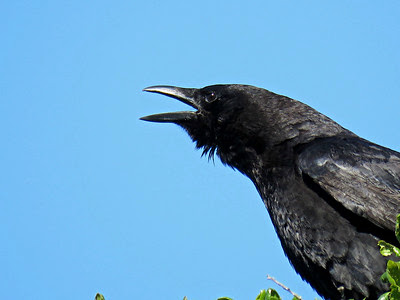This project has moved to a blog of its own: Fabulae Aesopi.
In this series of posts about the Latin verse fables of Desbillons, we have hit number 10! And for more about Desbillons, see the starting post. For each of Desbillons' 15 books of fables, I am picking out one very short poem as the focus. So, you'll find a poem-by-poem index to Book 10 below (linking to the pages at the Internet Archive), and here's the poem I selected from that book. It's a little bit longer than some of the other poems I've featured (there are not a lot of super-short poems in Book 10), but it's still not too hard to read:
10.12 Corvus Nimium Loquax
Repererat olim Corvus pinguem caseum;
Cum debuisset tacitus hac praeda frui,
Sua crociendo significare gaudia,
Bonamque sortem ovante gutturis sono
Annuntiare maluit, nimium loquax.
Corvi ergo plures advolant famelici,
Ruuntque, rixasque vehementes excitant,
Demumque opimam diripiunt huius dapem.
Here is the poem written out in English prose order to help in reading:
Olim
Corvus repererat pinguem caseum:
cum debuisset frui hac praeda
tacitus,
maluit,
nimium loquax,
significare sua gaudia crociendo
et annuntiare bonam sortem
ovante sono gutturis.
Ergo
plures corvi advolant,
famelici,
et ruunt
et excitant vehementes rixas,
demumque
diripiunt huius opimam dapem.
Desbillons does not give a source for this anecdote, which is actually a believable bit of natural history rather than an Aesop's fable. When I first saw the title about the too-talkative crow, and then the cheese in the first line, I thought it was going to be a version of the fox and the crow, but instead: it's all crows!
So now the next time you hear someone use the idiom "to crow about" something, you can think of Desbillons' little poem.
The meter is iambic, and here is some help with the meter (for more about iambic meter, see the post about Desbillons 1.1).
More poems in Desbillons, Book 10:
1. glires et fagus (lines: 17)
2. piscator (lines: 11)
3. rex et ludi magister (lines: 16)
4. musculus, felis et gallus (lines: 20+)
5. ranae et junci (lines: 13)
6. arbores duae (lines: 11)
7. viator, tirgris, et corcodilus (lines: 16)
8. navis et nauta (lines: 10)
9. serpens et eius filius (lines: 9)
10. canis astutia (lines: 20+)
11. canis venaticus et molossi (lines: 15)
12. corvus nimium loquax (lines: 8)
13. ovis et canis (lines: 13)
14. equus et muscae (lines: 15)
15. orator ad statuas (lines: 11)
16. turdi (lines: 20+)
17. asellus et rivus (lines: 15)
18. Iris et Phoebus (lines: 10)
19. cervus et piscator (lines: 10)
20. mus et talpa (lines: 20+)
21. chamaeleon (lines: 12)
22. villicus, felis, et caseus (lines: 16)
23. imago picta in camera (lines: 13)
24. homo etursus (lines: 20+)
25. vulturius, ostrea, et vulpis (lines: 16)
26. abes de creando rege deliberantes (lines: 20+)
27. puer et circumlitae saccharo nuces (lines: 17)
28. philomela et vespertilio (lines: 12)
29. myrtus et arbor magna (lines: 8)
30. avarus et graculus (lines: 10)
31. gallina plumis spoliata (lines: 20+)
32. ictericus (lines: 10)
33. asinus pelle leonis indutus (lines: 20+)
34. felis et canis (lines: 18)
35. agricola et eius filius (lines: 20+)
36. nux et arbores infructuosae (lines: 20+)
37. perdices duae et auceps (lines: 20+)
38. os et oculi (lines: 11)
39. adamas et artifex imperitus (lines: 9)
40. pratum, apis, et vipera (lines: 17)
41. sorex et mus (lines: 11)
42. ursa et leaena (lines: 6)
43. eruca et vipera (lines: 11)
Repere · rat o · lim Cor · vus pin · guem ca · seum;
Cum de · buis · set taci · tus hac · praeda · frui,
Sua cro · cien · do sig · nifica · re gau · dia,
Bonam · que sor · t~ ovan · te gut · turis · sono
Annun · tia · re ma · luit · nimium · loquax.
Corv~ er · go plu · res ad · volant · fame · lici,
Ruunt · que, ri · xasque ve · hemen · tes ex · citant,
Demum · qu~ opi · mam di · ripiunt · huius · dapem.
More poems in Desbillons, Book 10:
1. glires et fagus (lines: 17)
2. piscator (lines: 11)
3. rex et ludi magister (lines: 16)
4. musculus, felis et gallus (lines: 20+)
5. ranae et junci (lines: 13)
6. arbores duae (lines: 11)
7. viator, tirgris, et corcodilus (lines: 16)
8. navis et nauta (lines: 10)
9. serpens et eius filius (lines: 9)
10. canis astutia (lines: 20+)
11. canis venaticus et molossi (lines: 15)
12. corvus nimium loquax (lines: 8)
13. ovis et canis (lines: 13)
14. equus et muscae (lines: 15)
15. orator ad statuas (lines: 11)
16. turdi (lines: 20+)
17. asellus et rivus (lines: 15)
18. Iris et Phoebus (lines: 10)
19. cervus et piscator (lines: 10)
20. mus et talpa (lines: 20+)
21. chamaeleon (lines: 12)
22. villicus, felis, et caseus (lines: 16)
23. imago picta in camera (lines: 13)
24. homo etursus (lines: 20+)
25. vulturius, ostrea, et vulpis (lines: 16)
26. abes de creando rege deliberantes (lines: 20+)
27. puer et circumlitae saccharo nuces (lines: 17)
28. philomela et vespertilio (lines: 12)
29. myrtus et arbor magna (lines: 8)
30. avarus et graculus (lines: 10)
31. gallina plumis spoliata (lines: 20+)
32. ictericus (lines: 10)
33. asinus pelle leonis indutus (lines: 20+)
34. felis et canis (lines: 18)
35. agricola et eius filius (lines: 20+)
36. nux et arbores infructuosae (lines: 20+)
37. perdices duae et auceps (lines: 20+)
38. os et oculi (lines: 11)
39. adamas et artifex imperitus (lines: 9)
40. pratum, apis, et vipera (lines: 17)
41. sorex et mus (lines: 11)
42. ursa et leaena (lines: 6)
43. eruca et vipera (lines: 11)

No comments:
Post a Comment
Comments are limited to Google accounts. You can also email me at laurakgibbs@gmail.com or find me at Twitter, @OnlineCrsLady.